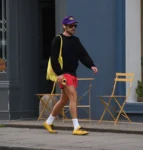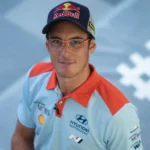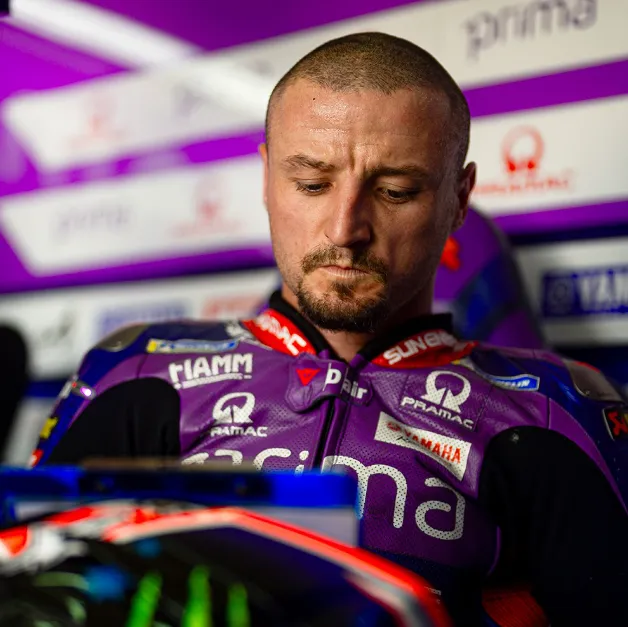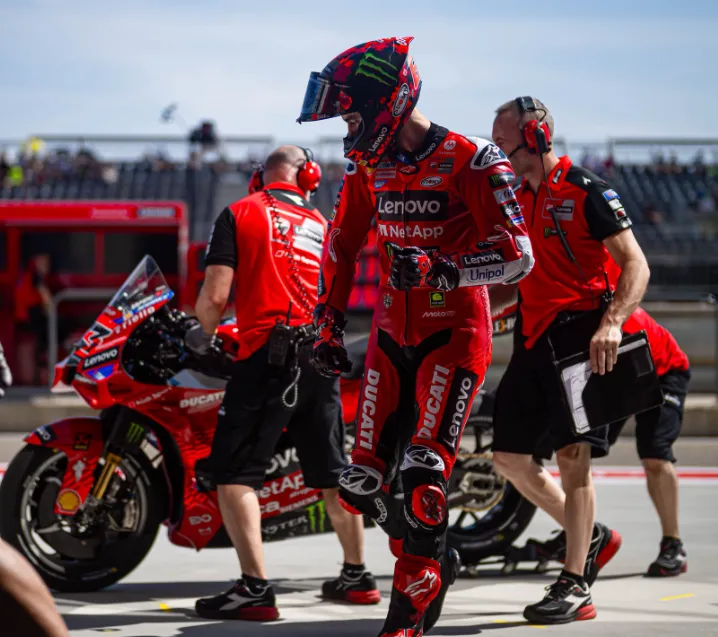

Aragon Trap: Quartararo Speaks Out About the Fear of Losing Control
In an emotionally revealing follow-up to his disastrous practice session at the Aragon Grand Prix, Fabio Quartararo opened up about his cautious approach heading into the sprint and main races. Still recovering from an 18th-place finish in free practice, the Yamaha factory rider admitted he considered pushing harder but opted against it to avoid a potential crash, citing a recurring corner exit problem and a growing lack of confidence in his machinery.
“When you don’t know what to expect, it’s the worst,” Quartararo said, in a stark warning that paints a grim picture of Yamaha’s current technical direction.
His message is clear: the unpredictability of the M1 is now so extreme, even a former world champion feels unsafe pushing it to the edge.
Medium Tire Denied: Yamaha’s Setup Decisions Raise Eyebrows
According to Quartararo, one of the main sources of frustration was his inability to test the medium rear tire—a compound he believed could have stabilized the bike during both practice and the upcoming MotoGP sprint race. Unfortunately, the medium was not available to him at a critical moment in practice.
“I wanted to make the last time attack with a medium tire but we didn’t have it,” Quartararo explained. “It was really, really tough to ride the bike.”
That decision has sparked criticism among fans and commentators alike. Why wasn’t the medium tire available during a session where Quartararo was already struggling with the soft compound’s inconsistency? Was it a strategy oversight, or a resource limitation?
In a situation this volatile, every compound matters—especially when a rider is searching for a stable base.

Corner Exit Chaos: Quartararo’s Diagnosis of the M1’s Fatal Flaw
While Yamaha engineers continue poring over data, Quartararo seems to have already identified the root of the problem: corner exits. And he’s not just pointing fingers—he’s connecting the dots between the M1’s rear grip issues and the mental toll they take on a rider’s confidence.
“Yes. Corner exit. And, of course, you exit bad, you want to brake later, then you go wide, then you make mistakes.”
It’s a vicious cycle. Quartararo’s need to compensate for bad exits by braking later only results in wider lines and more errors. This issue repeats lap after lap, and with no clear fix in sight, it’s no wonder he chose restraint over recklessness.
Controlled Aggression: Why Quartararo Chose Not to Push Harder
Despite his competitive nature, Quartararo made the mature decision to hold back, even if it meant giving up a spot in Q2. To some, this might appear as lacking fight—but in reality, it’s a sign of a rider thinking long-term and prioritizing survival over desperation.
“I was keeping trying, but at the last moment, I didn’t want to fly just to go into Q2. So I just wanted to keep calm.”
That phrase—“I didn’t want to fly”—is as chilling as it is telling. It underscores just how little trust Quartararo currently has in the M1. When a top-tier rider fears his bike might send him airborne during a standard push lap, something is very wrong.
Sprint Race Strategy: Will Yamaha Roll the Dice or Play It Safe?
Looking ahead to the MotoGP sprint, Quartararo remained realistic. Unless the team finds a miracle fix overnight, he’s prepared to use the medium tire for safety, even if it means sacrificing raw pace.
“Even with the sprint, if we still have the same issue tomorrow, I will make it with the medium.”
This decision, while wise, is also revealing: Yamaha is no longer in attack mode. They’re in damage control. Rather than aiming for podiums, the strategy now revolves around minimizing risk and staying upright—an astonishing reversal for a team that once dominated MotoGP.
Team Yamaha: Running Out of Time and Answers
Inside the Yamaha garage, the mood is reportedly tense. Engineers are running out of explanations—and patience. The corner exit issue, believed to stem from a combination of poor electronic traction control response and chassis geometry, continues to elude a definitive solution.
One source close to the team confirmed that even radical mapping changes haven’t produced consistent results, suggesting that the problem may be hardware-related rather than software-based. If true, that puts Yamaha in a difficult position: either accept a deeply flawed package for the rest of the season or attempt a rushed redesign that risks further instability.
Is Quartararo Losing Faith in Yamaha?
While Quartararo hasn’t publicly criticized his team beyond the technical issues, his tone is noticeably more jaded compared to past seasons. The once-optimistic prodigy is now a cautious, methodical veteran who knows his machine may not be up to the task.
This subtle shift is crucial. If Quartararo begins to doubt Yamaha’s ability to compete at the highest level, we could soon see contract tensions emerge. His loyalty has never been in question—but MotoGP is a results-driven sport. And right now, Yamaha isn’t delivering.
MotoGP Rivals Take Advantage: Ducati, KTM, and Aprilia Surge Forward
While Quartararo and Yamaha wrestle with setup woes, their rivals are thriving. Ducati riders consistently populate the top five, Aprilia’s Aleix Espargaró looks more competitive than ever, and KTM’s development curve continues to rise with riders like Brad Binder and Pedro Acosta closing the gap.
This contrast is damaging to Yamaha’s reputation. Once seen as one of the sport’s technological leaders, the brand now lags in key areas such as aerodynamics, torque delivery, and rear tire management. As the grid improves, Yamaha’s stagnation becomes more glaring by the week.
The Bigger Picture: What This Means for Yamaha’s MotoGP Project
Quartararo’s struggles in Aragon are not an isolated event—they’re part of a larger systemic issue. Yamaha’s failure to provide a predictable, competitive machine is now affecting not just race results, but the mindset of its star rider.
If Quartararo loses faith, sponsor confidence may also waver, especially as the MotoGP grid becomes increasingly competitive with multiple factories capable of winning races. Yamaha cannot afford to lose its lead rider—or the public’s trust.
Fans React to Quartararo’s Emotional Honesty
The MotoGP fan community, especially on platforms like X (formerly Twitter) and Instagram, responded with an outpouring of support for Quartararo. Many praised him for his mature approach and unfiltered honesty, while also expressing deep frustration with Yamaha’s technical direction.
“You can hear the disappointment in his voice, but also the class he has as a rider. Yamaha doesn’t deserve him right now,” wrote one fan.
Others demanded accountability: “How is this still happening in 2025? Where is Yamaha’s innovation?”

Can Quartararo Rebound in Time for the Race?
The upcoming sprint and main races in Aragon now hold extra emotional weight. Fans will be watching not to see if Quartararo wins, but whether he can survive, adapt, and salvage dignity in the face of mechanical adversity.
If Yamaha can’t solve these issues quickly, the rest of the season may be about damage limitation, not championship contention. And for a rider of Quartararo’s caliber, that’s a painful reality to accept.
Final Thoughts: The Calm Before the Storm or a New Low for Yamaha?
Fabio Quartararo’s warnings in Aragon are more than just complaints—they’re a rider’s honest cry for help, a plea to his team to rise to the challenge before it’s too late. His professionalism and self-restraint are commendable, but they also highlight the urgency of the situation.
Without drastic improvement, Yamaha risks wasting another season of one of MotoGP’s most talented stars. And for Quartararo, the question may soon shift from how do I fix this bike to how much longer can I stay here?
Stay tuned for what promises to be a make-or-break weekend for both Fabio Quartararo and Yamaha. The Aragon Grand Prix may yet offer redemption—or confirm that the team’s problems are deeper than anyone feared.



















Post Comment